Physical Address
304 North Cardinal St.
Dorchester Center, MA 02124
Physical Address
304 North Cardinal St.
Dorchester Center, MA 02124
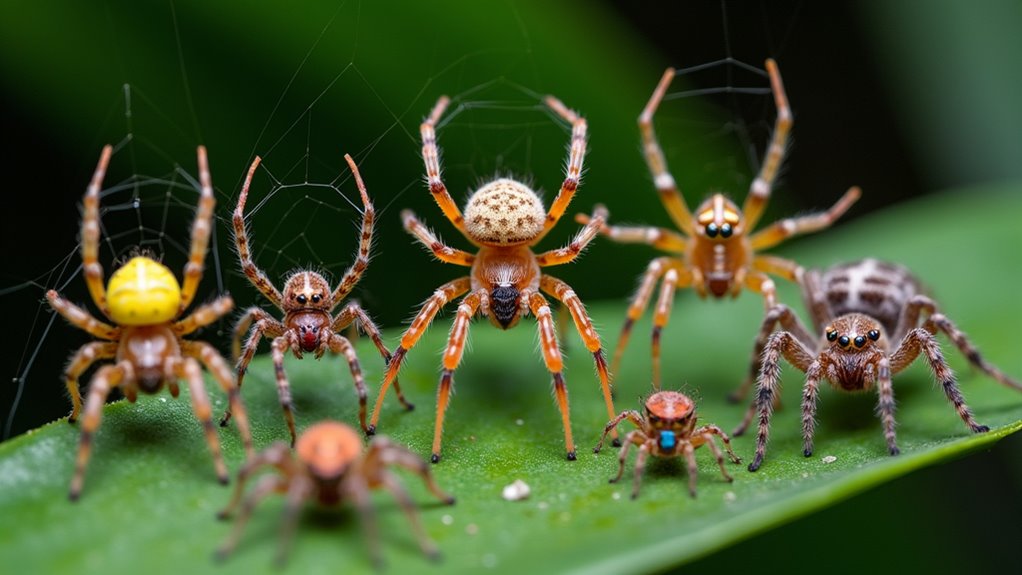
Spiders across the Philippines range from skull-patterned hunters to golden silk weavers, but which ones should you really worry about?
The Philippines hosts diverse spider species including the speedy Huntsman, web-spinning St. Andrew’s Cross, vibrant Hawaiian Garden Spider, and golden silk-weaving Batik spiders. You’ll also spot tiny Jumping Spiders with excellent vision, helpful Common Housefly Catchers that eliminate pests, and the distinctive Black and White Spiny Spider with its skull-like pattern. Though intimidating at first glance, these eight-legged creatures play essential ecological roles in the archipelago’s ecosystems.
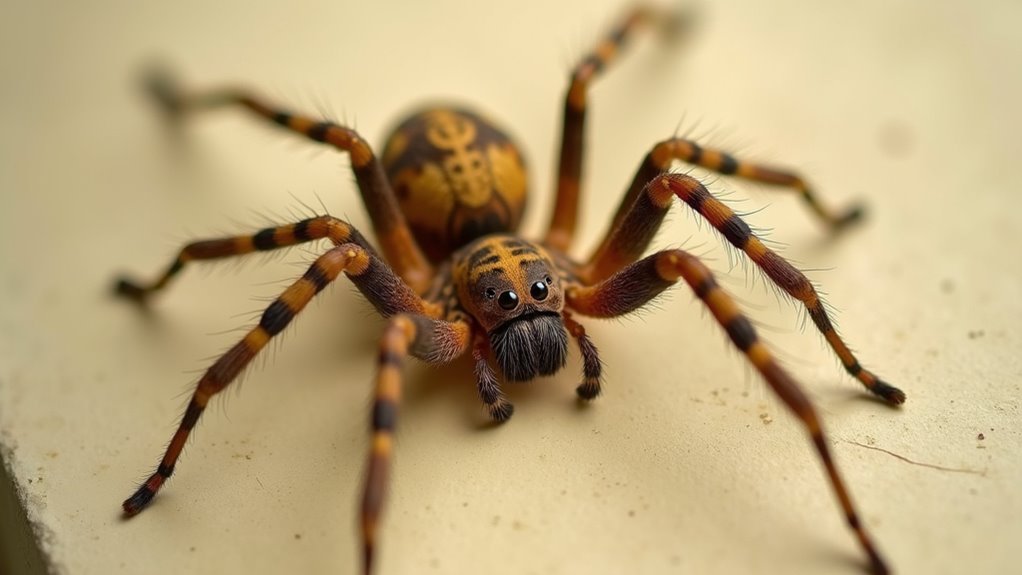
While you might mistake them for tarantulas at first glance, huntsman spiders are distinct arachnids with impressive physical traits and behaviors. With leg spans reaching 15 cm and crab-like sideways movement, these flat-bodied spiders can squeeze into tight spaces throughout your home.
You’ll find huntsman spiders particularly common in warm Philippine environments, often hiding under bark or in wall crevices. Don’t panic if you spot one indoors—they’re actually beneficial roommates that hunt cockroaches and other household pests. Male huntsman spiders produce rhythmic ticking sounds by vibrating their abdomen during courtship to attract females.
Though they move alarmingly fast (up to 1 meter per second), they’re generally not dangerous to humans. Their bites, while painful, rarely require medical attention.
Female huntsmans are protective mothers, fiercely guarding their egg sacks and young spiderlings.
These cathemeral hunters are active both day and night, using their decorated webs to attract prey and deter predators.
Their scientific importance can’t be overstated; researchers study them extensively for insights into sperm competition and mating behaviors.
Though primarily distributed along Australia’s east coast, you might encounter similar Argiope species in Philippine gardens. The Saint Andrews Cross Spider is easily identifiable by its distinctive cross pattern on the abdomen, making it one of nature’s most recognizable arachnids.
They’re beneficial predators that help control pest populations, so consider yourself lucky if you spot one of these natural artists in your outdoor spaces. Unlike in tourist destinations like Thailand, these spiders are more commonly found in the Philippines’ natural habitats.
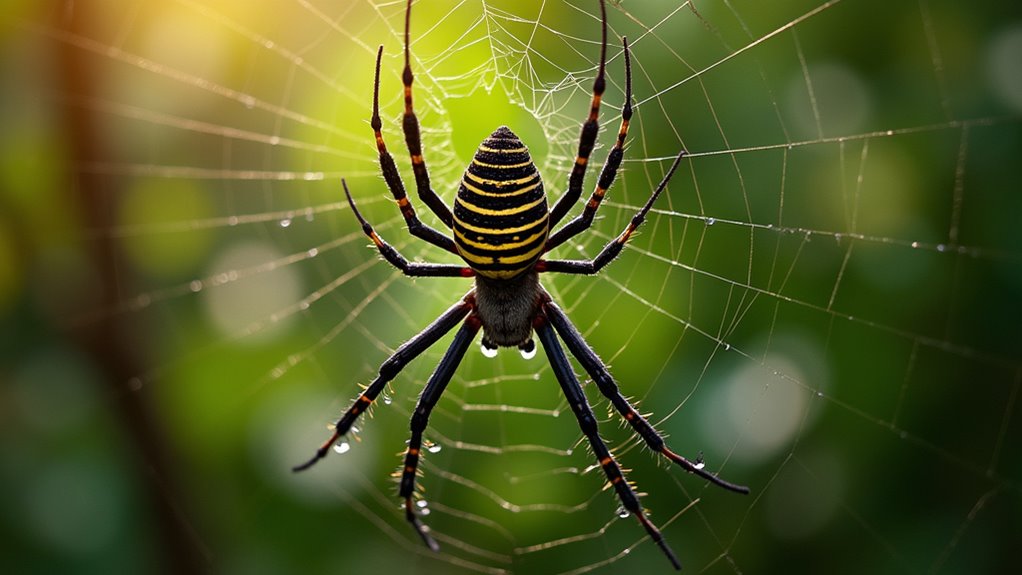
With its stunning yellow-striped abdomen, the Hawaiian Garden Spider appears prominent as one of the Philippines’ most recognizable arachnids. You’ll spot these impressive spiders in sunny areas like roadsides and garden edges during rainy seasons. These spiders become particularly active during the June to November period which coincides with increased rainfall in many regions.
Despite their name, they’re not native to Hawaii but were introduced there, along with Taiwan and New Guinea. For nature enthusiasts who enjoy outdoor adventures, these spiders offer fascinating observation opportunities in their natural habitat.
These efficient hunters play a crucial role in controlling insect populations, making them beneficial despite their intimidating appearance.
The Batik Golden Web Spider earns its reputation as a master architect through its spectacular golden silk constructions throughout the Philippines. This large orb-weaver, scientifically known as Trichonephila antipodiana, creates webs spanning over a meter in diameter between trees and shrubs.
You’ll spot these spiders by their silvery-grey to plum bodies with distinctly banded legs. Females are substantially larger than their tiny red-brown male counterparts—a classic example of extreme sexual dimorphism.
Their golden-hued webs aren’t just beautiful; they’re engineering marvels designed to catch flying insects in coastal shrublands and forest clearings. These spiders are well-documented in iNaturalist databases where citizen scientists contribute to mapping their distribution.
When threatened by predators like birds or wasps, they’ll vibrate their webs defensively. Visitors should practice proper etiquette when observing these spiders in their natural habitat, keeping a respectful distance to avoid disturbing their intricate constructions.
Despite lacking formal conservation assessment, these ecological pest controllers face growing threats from deforestation across their Southeast Asian range.
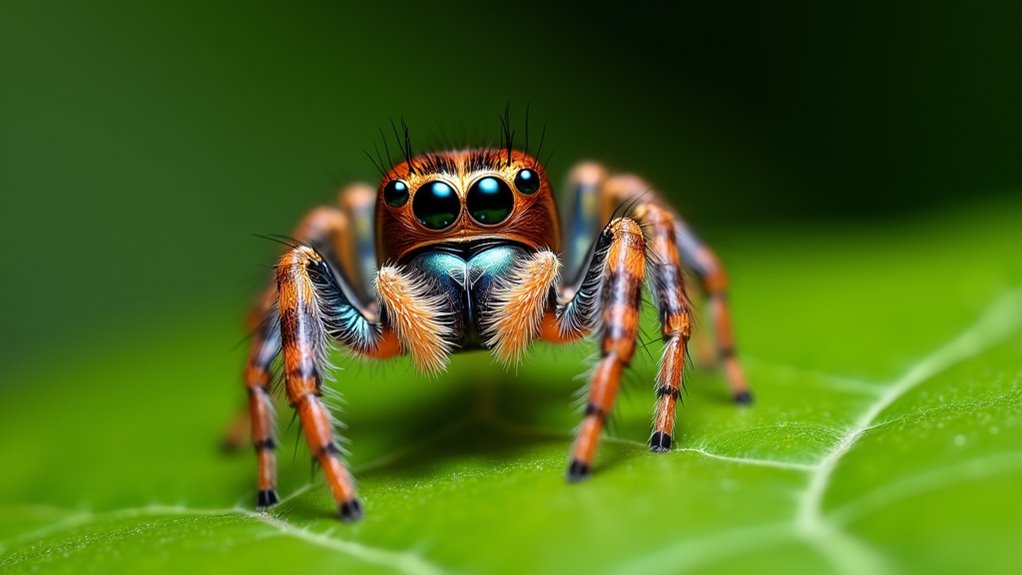
While the Batik Golden Web Spider catches prey in its majestic silk constructions, jumping spiders take a completely different approach to hunting. These charismatic arachnids rely on exceptional vision and athletic leaps to ambush their targets during daylight hours.
The Philippines boasts impressive jumping spider diversity, including endemic genera like Lepidemathis and the recently discovered Orthrus calilungae from Luzon. The Lepidemathis genus recently expanded from four to seven species with discoveries in various provinces on Luzon island. You’ll spot these tiny hunters anywhere from citrus groves to building exteriors, especially on sunlit surfaces. For a responsible wildlife encounter, always observe these fascinating creatures without disturbing their natural habitats.
Among the many beneficial spiders inhabiting Filipino homes, Plexippus petersi, commonly known as the Common Housefly Catcher, is prominent as your natural pest control ally.
Originally from Southeast Asia, these small hunters (6-10mm) are easily identified by four black oval spots on their brown, hairy bodies. These spiders have a distinctive appearance with four pairs of eyes, including one larger, forward-facing movable pair that helps with hunting.
You’ll find these jumping spiders indoors and in crop fields, where they actively hunt mosquitoes and flies without building webs.
They’re excellent jumpers, using this skill to catch prey day and night.
Don’t worry about their presence—their venom isn’t toxic to humans.
At worst, their bite causes minor redness similar to a bee sting.
These spiders contribute to making the Philippines one of the safe Asian destinations for nature enthusiasts exploring the country’s biodiversity.
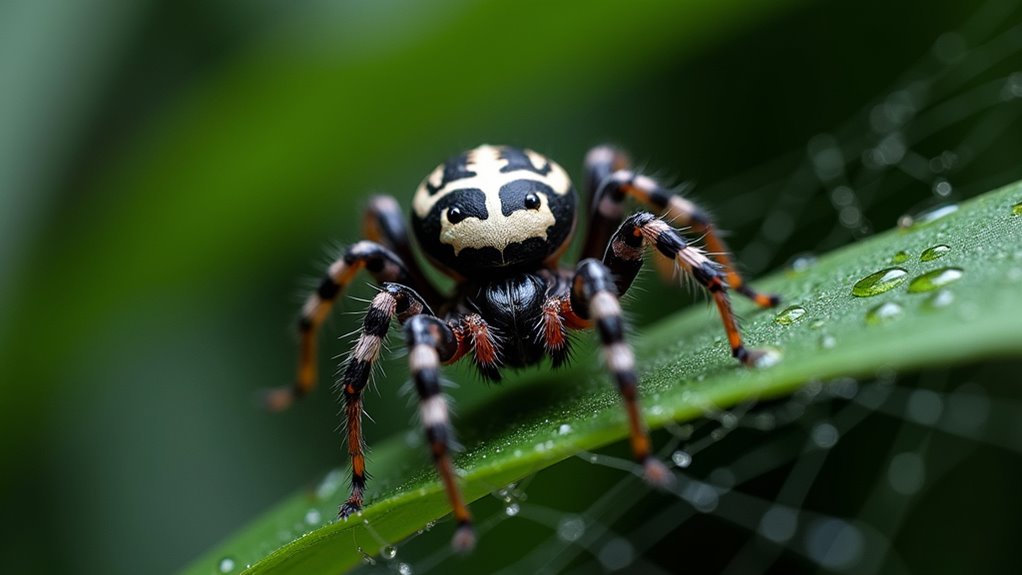
Moving from indoor hunters to garden defenders, you’ll need to familiarize yourself with the striking Gasteracantha kuhli, aptly nicknamed the Black and White Spiny Spider for its skull-like pattern. This distinctive orb-weaver constructs webs at least 2 meters above ground between trees or shrubs.
When you spot one, you’ll notice:
Don’t worry about these spiders harming you—their venom is mild and they’re actually beneficial, capturing mosquitoes and other pests. These fascinating creatures are widely distributed throughout Southeast Asian countries, from India to Japan and across the Philippine archipelago.
While intimidating in appearance, these spiny defenders prefer to retreat quickly when disturbed rather than confront potential threats.
You’ve now met the eight-legged neighbors sharing your Philippine home. While they might make your skin crawl, remember they’re keeping your ecosystem in balance. Next time you spot a huntsman racing across your wall or a jumping spider watching you with those curious eyes, you might think twice before reaching for your slipper. After all, you’re never truly alone in your home—they were here first.